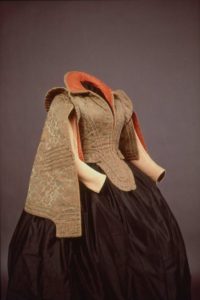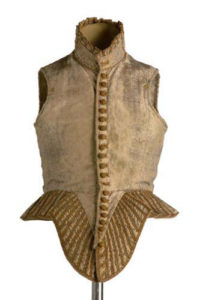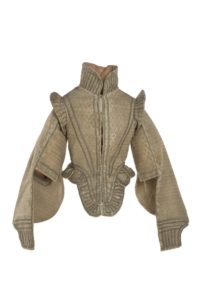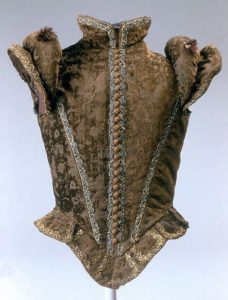I’m cheating, these are all doublets.

Museum of Fine Arts, Boston
Costume bodice, Spanish, possibly early 20th century, in the style of about 1600
If this is a copy it’s a remarkable wonderfully accurate copy! I know there was a lot of interest in historic costume and collecting extant items in the late 19thC especially but this has a good cut.So I’m keeping this here until I know for sure. There is a fold under the right arm that looks like a long dart, but that would be closer to the 1950s in terms of placement, as the same kind of side darts in the 1920s were shallower and longer on the whole.
So if this is a copy, this is the kind of copy I aspire to. It’s so well made that you have to look for details that show modern workmanship- the weave of the fabric, the order of construction, and nods to contemporary wishes. However this bodice keeps the conical shape while fitting for a more curvy shape than the fashionable ideal. The curved front join is correct for the period but also only until the late 19thC and it’s rare to see a garment deviate from established systems of cutting.

Museo del Traje- Jubón
Jubón femenino de seda con bastas flotantes por urdimbre de color gris que dibujan una decoración en zig-zag y roleos.
This is very definitely of the time! But it is for a different body type. This is almost certainly intended to be worn under a ropa as there are no shoulder wings.

Les Arts Décoratifs- Costume: pourpoint espagnol
Création: France, 1589-1610, Henri IV
Now this is what I mean by the MFA looking so close to the original. The placement of the trim (There are two distinct placements of trim on Jubons) the shape of the shoulder wings, the texture of the main fabric, the shape of the nib front, the proportion of the waist tabs. The most obvious difference is the set of the shoulders in the MFA.
As far as fitting this has a very similar method of shaping, which is to do the bulk of the general size in the back and pull the fabric from the sides to the front to pinch out for customised fit. You bring in under the bust and to the waist then smooth over the bust and over the point. And spread the fabric from the bust up and out to the shoulders. This way the most stable part of the fabric, the closest to the grain is under the bust and to the waist which then allows some ease over the bust and to the throat.
This is sort of similar to Victorian fitting as well and was mainly lost in modern pattern draping and drafting systems. It is still seen today in modern tailoring. ANd that is because these garments above were made by a tailor, dress making came about with the rise of the Mantua and lead to a very different kind of patterning and construction.

The Metropolitan Museum of Art-Jerkin
Date:1570–80
Culture:European
Medium:silk, metal thread
Credit Line:Gift of Bashford Dean, 1926
Accession Number:26.196
This garment is earlier than the rest but shows a shaping feature often overlooked in the various tailoring books, the side front seam. This appears to be optional as they are only drawn in occasionally but they do sit in the same place. But you can see some issues with trying to sew on this slight curve on the outside of the seam to our right. There is more fabric eased on the outer curve than on the opposite side.
This garment was patterned for Blanche Payne’s History of Costume. It’s not easier than the normal three part bodice types but it does allow for a little more ease over the bust and into the armscye.
 When: Saturday 3 September, 2pm – 3.30pm
When: Saturday 3 September, 2pm – 3.30pm



